Louisville forecast 2017
Executive Vice Chancellor for Academic Affairs and Sanders Chair in Business, Indiana University Southeast, New Albany
Last year’s outlook forecasted “job gains, but at a slower pace than in recent years” in 2016. The Louisville metro ended 2015 with an above-average addition of nearly 20,000 jobs, but as of August 2016, the year’s job gains are off from previous years. As we approach the second half of the year in data availability, Louisville added approximately 4,800 jobs as of August, which is below the average August-to-date job gains of 9,800 over the past three years. As we approach 2017, we expect job gains to accelerate once again, and 2017 will be another year with impressive job growth. Southern Indiana counties should see strong job gains as River Ridge continues to develop and both the downtown and East End bridges finally open.
Employment
The U.S. economy saw slower growth during the first half of the year, evident through lower gross domestic product (GDP) growth numbers. This slower national growth also shows up in slower Louisville metro payroll gains for the first half of the year (see Figure 1).
Figure 1: Louisville metro nonfarm payroll jobs
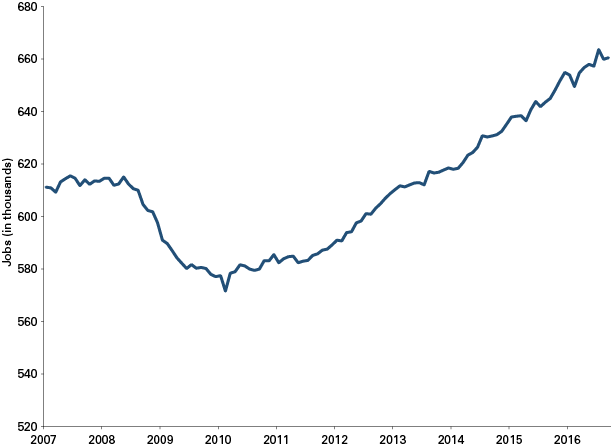
Source: Factset
Sector payroll employment changes are mixed. Both retail and education and health services saw significant gains over 2016 and continue to increase, but the retail sector is now showing significant deceleration from earlier in the year (see Figure 2). Professional and business services, along with leisure and hospitality, also experienced a slowdown in growth, adding to the overall moderation in job gains for the Louisville metro.
Figure 2: Year-over-year percent change in payroll jobs for selected Louisville metro sectors, October 2011 to September 2016
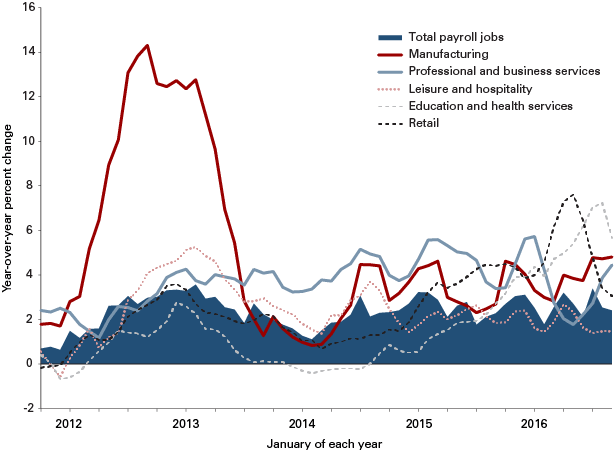
Source: Factset
However, as the national economy expands in 2017, both professional and business services and the local leisure and hospitality sectors will return to stronger growth in the metro area. The professional and business services sector is already beginning to accelerate compared to overall payroll growth.
U.S. manufacturing experienced slower growth at the start of the year, but this is not evident in regional manufacturing growth. Regional manufacturing payrolls did slow down earlier in the year, consistent with national manufacturing. However, manufacturing sector growth was slightly above overall payroll growth. Over the second half of the year, manufacturing is now accelerating once again, with a pace that exceeds overall job growth. An expanding regional manufacturing sector will be expected to contribute favorably to overall metro job growth.
Southern Indiana
Southern Indiana (Clark, Floyd, Harrison, Scott and Washington counties) saw impressive payroll gains over 2016. The fourth quarter of 2015 saw a record addition of more than 5,000 payroll jobs, year over year (see Figure 3). Outside the fourth quarter, Southern Indiana produced solid gains over the entire year. While there will likely be payroll deceleration in some quarters, expectations are that these job gains will continue. The sustained development of River Ridge and the opening of both Ohio River bridge crossings expect to produce strong growth for the Southern Indiana counties. Much of this growth will be concentrated in Clark County. However, surrounding counties will also benefit due to commuting patterns and suppliers located in the region.
Figure 3: Change in Southern Indiana payroll jobs over time
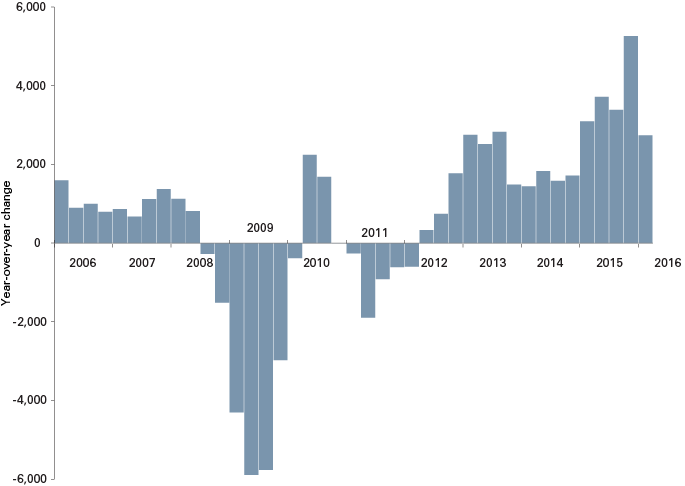
Source: STATS Indiana, using Quarterly Census of Employment and Wages data
The most recent data available (first quarter 2016) show that retail, manufacturing, and transportation and warehousing were the highest-performing sectors in Southern Indiana in terms of job growth. Administrative, support and waste management and remediation services was the only sector with a noticeable decline for the first quarter of 2016 (see Figure 4).
Figure 4: Change in Southern Indiana payroll jobs for selected sectors
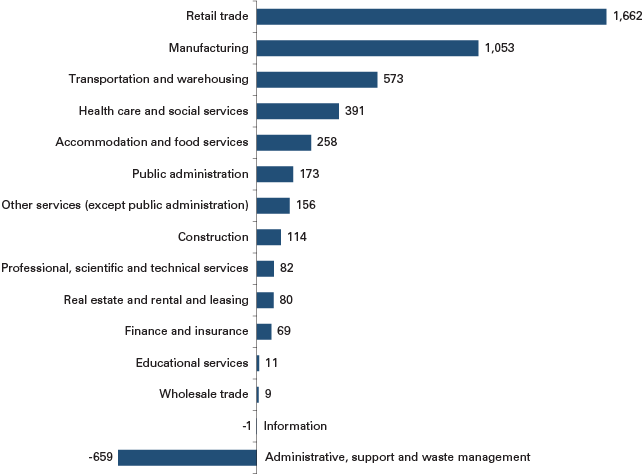
Note: This year-over-year change is from 2015 Q1 to 2016 Q1.
Source: STATS Indiana, using Quarterly Census of Employment and Wages data
Building permits
Clark County remains a leading producer of building permits in Southern Indiana (see Figure 5). Preliminary data for 2016 show that building permits for Floyd and Harrison counties are on pace to exceed total activity for 2015. As of August 2016, Floyd and Harrison counties are now at 168 and 102 permits, respectively. In fact, total permits for Harrison County in 2016 have already exceeded total permits in 2015. As Clark County continues to show growth associated with River Ridge, surrounding counties should also benefit from additional building activity. Local quality of place and economic development initiatives in Harrison County will continue to increase its overall attractiveness, and this may be reflected in these impressive building permit data for 2016.
Figure 5: Total building permits for selected Southern Indiana counties
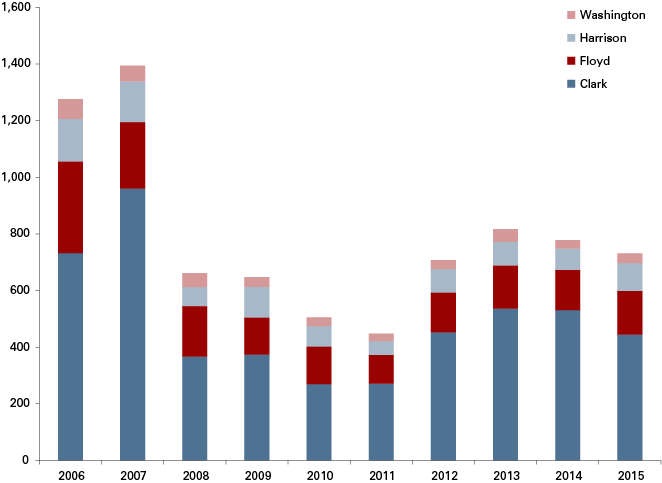
Source: State of the Cities Data Systems
Outlook
Last year’s forecast expected strong gains across Southern Indiana. The data now show that Southern Indiana experienced record gains going back as far as 2001. The outlook expected continued gains for the entire metro area, but at a somewhat moderate pace. The Louisville metro will produce another year of gains, but 2016 is now at a pace that is lower than the average of the prior three years. We do expect growth to pick up the last quarter of 2016, however.
For 2017, expectations are somewhat similar to 2016. We expect another year of solid gains for Southern Indiana. Manufacturing indicators are beginning to improve relative to the first half of the year; although, there are national indicators that show uncertainty with respect to the national manufacturing environment. However, despite this uncertainty, the Louisville metro will show gains for 2017. The nation will be moving past the slower growth of the first half of the year, and this is going to show up locally through additional acceleration in the manufacturing and transportation and warehousing sectors. There will likely be tightening in monetary policy, but consumer demand and continued gains in national payrolls will produce solid payroll gains for the metro area.
In conclusion, the outlook is favorable for both Southern Indiana and Louisville. Expect gains to exceed 2016 payroll growth for the Louisville metro at an above-average pace.



